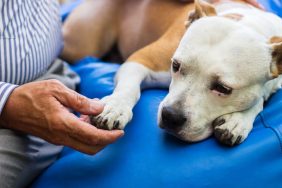Researchers at The Pine Street Foundation, a research center in San Anselmo, California, have discovered that dogs have the ability to detect cancerous tumors earlier and more accurately than conventional diagnostic methods such as mammograms and x-rays.
“We were intrigued by studies showing how dogs could detect cancer by sniffing the urine samples of patients,” says Dr. Michael McCulloch, Pine Street’s lead researcher. “We decided to embark on our own study to see if dogs could use their extraordinary sense of smell to distinguish people with lung and breast cancer from healthy controls.”
Lung and breast cancers are the leading cause of cancer deaths worldwide. According to the American Cancer Society (ACS), about 165,000 people in the United States die from lung cancer each year, and about 210,000 new cases are diagnosed. An estimated 182,480 new cases of invasive breast cancer will be diagnosed each year, and an estimated 40,480 women will die from the disease.
“Lung and breast cancers are often diagnosed at later stages, when the prognosis isn’t good,” McCulloch says. “Our goal was to see if dogs could use their sense of smell to detect cancer at its earliest stages.”
In the Pine Street study, three Labradors and two Portuguese Water Dogs were trained to sniff out 55 cases of lung cancer and 31 cases of breast cancer using breath samples, differentiating them from the scents of 83 healthy control subjects. The dogs were clicker-trained in the same manner used to train bomb detection canines.
The training process begins with a control group comprised of both cancer patients and healthy participants exhaling into a plastic tube. The tubes, which capture microscopic particles from each person’s breath, are then placed in bowls one yard apart from each other, while the dogs wait in an adjacent room. The dogs are then brought in and go down the line of bowls, sitting only when they detect a malignancy.
“Cancer patients have been shown to have traces of chemicals such as alkanes and benzene derivatives in their breath,” says McCulloch. “A dog’s nose can smell up to 10,000 times better than we can, enabling them to pick up scents.”
The initial research conducted at Pine Street was astounding. In a study published in the March 2006 issue of the journal Integrative Cancer Therapies, McCulloch reported the dogs in his study detected breast and lung cancer through breath samples with sensitivity and specificity between 88% and 100%.
But don’t expect to see dogs working in oncology units any time soon. McCulloch hopes the research will translate into the development of an “electronic nose,” device that doctors could use as a routine cancer-screening tool.
“We’d ultimately like to see a breathalyzer type of test being used that could detect cancer earlier than current tests,” McCulloch says. “By diagnosing cancer earlier, and through less invasive methods, the disease could be treated effectively, possibly through surgery, before it metastasized to other parts of the body.”
Buoyed by their success with lung and breast cancer trials, McCulloch and his staff have embarked on a new research study to determine if dogs can also detect ovarian cancer at its earliest stages. The National Cancer Institute (NCI) says that 21,650 women will be diagnosed with ovarian cancer this year and that 15,520 will die from the disease.
Cancer researchers find the work of the Pine Street Foundation promising.
“The ability to detect cancer, particularly ovarian cancer, in its early stages, would make significant strides in reducing the burden of this disease,” says Scarlett Gomez, PhD., a research scientist with the Northern California Cancer Center, a nationally recognized leader in researching the causes of cancer and improving the prevention and detection of cancer. “Unfortunately, ovarian cancer prognosis is extremely poor, in large part due to the fact that most patients are diagnosed at a late stage.”
Pine Street is collaborating with researchers at the University of Maine on the ovarian cancer project, using four Labradors and a miniature poodle to sniff out tumors. McCulloch notes that many of the dogs were originally trained at Guide Dogs for the Blind in San Rafael, California.
“We call these dogs ‘career changers,” McCulloch says. “They didn’t pass the rigorous training to become a guide dog because they were more interested in smelling than seeing, which is perfect for our purposes.”
The research being conducted with cancer-sniffing dogs isn’t limited to The Pine Street Foundation. Research has been ongoing since 1989, when the British medical journal The Lancet reported that a dog kept sniffing at a mole on his owner’s leg. A doctor’s visit revealed that the mole was melanoma, a deadly form of skin cancer. Other researchers in Florida, the U.K., Japan, and Australia are also working on similar studies.
While dogs are showing extraordinary potential in detecting cancer, McCulloch advises not to become alarmed when your own dog begins to sniff your body parts.
“We only recommend medical follow-up for people whose dogs display persistent and animated behavior around specific body locations on their owners for a significant amount of time,” McCulloch says. “If your dog consistently returns to smell a specific area of your body over several weeks, in a way that’s new or unusual, he or she may be trying to tell you something.”
-Linda Childers









